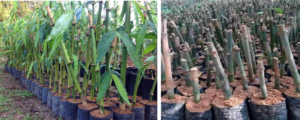Bamboo, nicknamed the wonder plant, is the strongest and fastest-growing monocot “woody” plant on earth, great for construction work. It is packed with vitamins and essential minerals such as niacin, vitamin A, vitamin B6, and vitamin E, which is the body’s most powerful antioxidant. It is known to naturally enhance collagen production, help to detox the body, and boost natural immunity.
In addition to that, did you know that it sequesters more carbon in average compared to other tropical trees? It has been reported that bamboo releases more oxygen to the air compared to other tropical trees. The oxygen released is directly related to the amount of carbon sequestered. The formula for calculating the net oxygen production of trees or bamboo is the following: net O2 released(kg/yr) = net C sequestration (kg/yr) x32/12
Reports state that the average tropical tree sequesters 22.6kg of carbon per year over a period of 10 years, whereas the average Guadua Bamboo clump will sequester 77 kg of carbon a year over a period of 7 years. However, a plantation of tropical trees counts on average 600 trees per hectare, whereas the average Guadua plantation will only count 278 clumps.
If we simplify the above data by translating the numbers to tons per hectare, then Guadua sequesters on average 150-ton carbon per hectare (7 years after planting), vs tropical trees with an average of 95-ton carbon per hectare (7 years after planting).
In net oxygen production this means 400 ton for Guadua vs 253 ton for tropical trees. So, in this comparison it can be concluded that bamboo produces 58% more oxygen than trees.
At Nature Diversity Organization, we encourage biodiversity conservation and put all efforts towards carbon offset by propagating bamboo seedlings and encouraging the public to grow them. The seedlings are now available at Nature Diversity.

